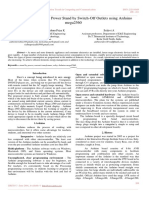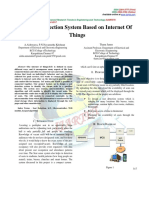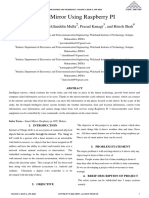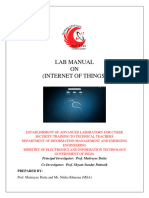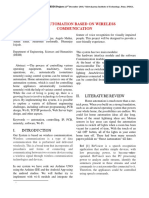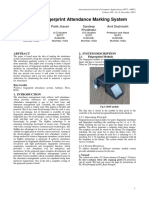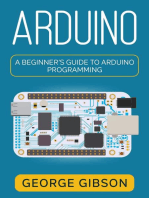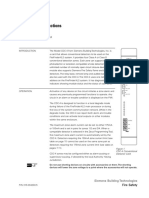Professional Documents
Culture Documents
Implementation of Low-Cost Data Glove To Use in Virtual Reality Systems Using Hall Sensor
Original Title
Copyright
Available Formats
Share this document
Did you find this document useful?
Is this content inappropriate?
Report this DocumentCopyright:
Available Formats
Implementation of Low-Cost Data Glove To Use in Virtual Reality Systems Using Hall Sensor
Copyright:
Available Formats
Volume 4, Issue 3, March – 2019 International Journal of Innovative Science and Research Technology
ISSN No:-2456-2165
Implementation of Low-Cost Data Glove to use in
Virtual Reality Systems using Hall Sensor
1 2
D. Venkata Siva Prasad K. Priyanka
Asst Professor, ECE ECE,
BVRIT Hyderabad College of Engineering for Women, BVRIT Hyderabad College of Engineering for Women,
Hyderabad, India Hyderabad, India
3 4
M. Shree Keerthana D. Srilatha
ECE, ECE,
BVRIT Hyderabad College of Engineering for Women, BVRIT Hyderabad College of Engineering for Women,
Hyderabad, India Hyderabad, India
5
G. Teja Sri
ECE,
BVRIT Hyderabad College of Engineering for Women,
Hyderabad, India
Abstract:- The primary point of this paper is to execute B. Proposed System
a low-cost information glove utilizing hall sensor, In addition, with the tracking of the object, we can
Arduino NANO (ATMEGA328P microcontroller) and even able to control our system with by our hand using this
Processing IDE. This glove is utilized in virtual reality glove without any contact with the system this will happen
condition and is incorporated into a suite of utilization. we simply wave our hand in front of our system or laptops.
When we wear the glove to our hand and wave it before
the PC, we will almost certainly move the pointer to the C. System Specifications
ideal area and play out a particular undertaking.
Scope of system specifications
Keywords:- Arduino NANO, Processing IDE, Data Glove. This framework determines the description of the
function and the execution of the system and the user. The
I. INTRODUCTION purpose of this task is to manage and control our system
without any touch pads or stylus, by simply waving our
Virtual Reality is a computer-generated simulation hand in front of the screen.
environment that makes everyone to experience the
impossible. It can be explored and interacted by a person System Description
using specific electronic equipment like a helmet or a glove This framework has two sections to be specific
fitted with sensors. Virtual reality means an artificial hardware and software. The hardware here used is
environment. Communication systems means the VR ATMEGA328P microcontroller which is a 28 pin IC, and
systems which includes sensations and transmission of the Hall Effect sensor. The software part used is Processing
vibration to the user by devices is known as kinaesthetic IDE and Arduino IDE.
communication systems. This is used in gaming zones,
military training and medical applications. This VR system II. HARDWARE USED
also refers to Virtual presence of users with artifact in
remote communication environment. The following is the description of the hardware parts
used in this project:
A. Previous System
Previously we can able to track a particular object A. Arduino Nano
when something that points the object, which depends on Arduino Nano is a microcontroller board dependent
the RGB color combination. Later it is developed as a stylus on the ATmega328P. It has 14 digital input/output pins (of
to work with the smart board and scribble pad. which 6 can be utilized as PWM outputs), 8 analog inputs,
2 reset pins, 6 power pins, a 16 MHz quartz crystal, a USB
As the any color combination which include red, green, or connection, a power jack, an ICSP header and a reset
blue or some other color which has the more intensity is button. It has everything expected to help a
used for the object to be tracked. Once the program is done microcontroller. It has same usefulness as arduino UNO
with the image processing the specified color is tracked. yet it is in little size. Variety of microprocessors and
And this kind of mechanism is mostly seen in major controllers are used by arduino board designs. A set of
supermarkets to identify and bill the fruits. digital and analog input/output (I/O) pins are equipped in
the board. These are utilized to interface different
extension boards (shields) and different circuits. In some of
IJISRT19MA692 www.ijisrt.com 791
Volume 4, Issue 3, March – 2019 International Journal of Innovative Science and Research Technology
ISSN No:-2456-2165
the models the board features serial communications
interfaces. It is Universal Serial Bus (USB), this is used for
loading programs from personal computers. Programming
languages like C and C++ are used for programming the
microcontroller.
Fig 3
C. Bluetooth Module
Bluetooth module is intended to setup a wireless
serial connection. The HC-05 Bluetooth module has two
arrangements, Master and Slave setup. By default, it is in
SLAVE configuration. The Master or Slave can be
Fig 1
arranged just by AT COMMANDS. A Slave module
cannot start a connection with another Bluetooth device,
B. Hall Sensor
but can pair with other devices. Master module can start a
Hall Effect Sensor is a transducer that changes its
connection to other devices. The user can utilize it setting
output voltage with respect to the external magnetic field
up a sequential port replacement to build up association
applied on it. Magnetic field has two important
between MCU and GPS, PC to your embedded project, etc.
characteristics. They are flux density and polarity (south
and north poles). Hall Sensor has the following applications
like proximity switching, positioning, speed detection, and
current sensing applications. In a hall-effect sensor, there is
a thin metallic strip with current flowing through it. In the
presence of an external magnetic field the electrons are
deflected towards the edge of the metal strip, this produces
a voltage across the short-side of the strip (perpendicular to
the feed current). At the point when the magnetic flux
density around the sensor surpasses a certain pre-set limit,
the sensor distinguishes it and produces a certain voltage
called Hall voltage. These sensors have the favorable
position that they can recognize static (non-changing)
magnetic fields.
Fig 4
III. SOFTWARE USED
Software part utilized in this project is described below:
A. Arduino IDE
The Arduino Software (IDE) or Arduino Integrated
Development Environment – consists of an editor of text
type to compose code, a message zone, a text console, the
distinctive buttons on toolbar for functions that are
commonly utilized and diverse menus. It interlinks the
Arduino equipment to upload the program and to interact
with them. It is a cross platform Java application that is
Fig 2 used as an editor of code and compiler and is also suitable
for assigning the firmware to the board in a serial manner.
IJISRT19MA692 www.ijisrt.com 792
Volume 4, Issue 3, March – 2019 International Journal of Innovative Science and Research Technology
ISSN No:-2456-2165
IV. BLOCK DIAGRAM
The Block diagram for this project is as follows,
Fig 5
B. Processing IDE
It is an integrated environment and open source
language of computer programming developed for Fig 7
electronics arts, new media arts, and communities of
Working Principle
optical design. The main aim is to teach the fundamental
programming language in an optical setting and it is a Once the connection has been made as per the block
diagram, the LED on the Bluetooth module must glow
software sketchbook which is very flexible. Processing has
stable which means the connection has been established
created another undertaking, Wiring, that utilizes the
between the hardware and software. And we will get the
Processing IDE with a set of libraries which are composed
in the C++ language so as to teach artists the approaches to calibration screen upon running the program, where we are
going to trace the object on the glove and to calibrate the
code microcontrollers. At present there are two diverse
hardware projects to be specific Wiring and Arduino, Hall Sensor, it gives the message as all sensors are active.
utilizing the language as well as Wiring environment. When the calibration is completed, we get a home screen
Fritzing is also a similar software environment, which with a blue background. We have the two options one is
supports designers and artists in documentation of their the paint screen and other is the LED toggle screen.
prototypes which are interactive and to make a forward Therefore, when we wave our hand before the web camera,
step towards actual product from a basic physical the hall sensor is able to find the position and helps to drag
prototype. the screens and we are able to operate our system with no
contact with the system.
V. CONCLUSION
Finally, we structured the glove for use in Virtual
Reality frameworks and is incorporated into a suite of
applications and we can wave our hand before the PC and
move the pointer to the ideal area and perform some tasks
REFERENCES
[1]. Aroca, Rafael V.; Gomes, Rafael B.; Dantas,
Rummennigue R.; Calbo, Adonai G.; Gonçalves,
Luiz M.G. 2013. "A Wearable Mobile Sensor
platform to Assist Fruit Grading." Sensors 13, no. 5:
61096140. (references)
[2]. Deliang Zhu, Zhiquan Feng, Bo Yang, Yan Jiang,
Tiantian Yang. The Design and Implementation of
3D Hand-based Human Computer Interaction. 20IO
International Conference on Computer Application
Fig 6
and System Modeling (ICCASM 2010).
[3]. Faludi, Robert (January 4, 2011), Building Wireless
Sensor Networks: with ZigBee, XBee, Arduino, an
Processing (1st ed.), O'Reilly Media, p. 320, ISBN
978-0-596-80774-0.
IJISRT19MA692 www.ijisrt.com 793
Volume 4, Issue 3, March – 2019 International Journal of Innovative Science and Research Technology
ISSN No:-2456-2165
[4]. Vantomme, Jan (September 20, 2012), Processing 2,
Creative Programming Cookbook (1st ed.), Packt
Publishing, p. 291, ISBN 9781849517942.
[5]. Slater, Mel; Guger, Christoph; Edlinger, Guenter;
Leeb, Robert; Pfurtscheller, Gert; Antley, Angus;
Garau, Maia; Brogni, Andrea; Friedman, Doron
(2006-10-01)."Analysis of Physiological Responses to
a Social Situation in an Immersive Virtual
Environment". Presence: Tele operators Virtual
Environments. 15 (5): 553–569.ISSN 1054-7460.
doi:10.1162/pres.15.5.553.
[6]. Peck, Tabitha C.; Seinfeld, Sofia; Aglioti, Salvatore
M.; Slater, Mel (September 2013). "Putting yourself
in the skin of a black avatar reduces implicit racial
bias”. Consciousness and Cognition. 22 (3): 779787.
ISSN 10902376.
[7]. Reger, Greg M.; Holloway, Kevin M.; Candy,
Colette; Rothbaum, Barbara O.; Difede, JoAnn;
Rizzo, Albert A.; Gahm, Gregory A. (2011-02- 01).
"Effectiveness of virtual reality exposure therapy for
active duty soldiers in a military mental health clinic".
Journal of Traumatic Stress. 24 (1): 9396. ISSN
15736598. doi:10.1002/jts.20574.
[8]. Steve Aukstakalnis:( 2013). “Practical Augmented
Reality: A Guide to the Technologies, Applications
and Human Factors for AR and VR (Usability). ISSN
10802678.
IJISRT19MA692 www.ijisrt.com 794
You might also like
- Health Care System Using Embedded SystemDocument8 pagesHealth Care System Using Embedded Systemparth_iarjunNo ratings yet
- A Review: Biometric Fingerprint Recognition For Bus Ticket SystemDocument3 pagesA Review: Biometric Fingerprint Recognition For Bus Ticket SystemEditor IJRITCCNo ratings yet
- Interactive Monitoring and Controlling System ForDocument5 pagesInteractive Monitoring and Controlling System ForSchields PedroNo ratings yet
- Implementation of Ac Power Stand by Switch-Off Outlets Using Arduino Mega2560Document4 pagesImplementation of Ac Power Stand by Switch-Off Outlets Using Arduino Mega2560Editor IJRITCCNo ratings yet
- Brain Computer Interface and Arduino Microcontroller Software Interconnection Solution IJERTCONV6IS15090Document4 pagesBrain Computer Interface and Arduino Microcontroller Software Interconnection Solution IJERTCONV6IS15090behijNo ratings yet
- Embedded Systems-Backbone of IotDocument7 pagesEmbedded Systems-Backbone of IotReema Bin TabitNo ratings yet
- Embedded Lab: Arduino Projects in Science LessonsDocument6 pagesEmbedded Lab: Arduino Projects in Science LessonskhalidNo ratings yet
- Iot Based Home Automation System With Wifi On Arduino Using Android ApplicationDocument7 pagesIot Based Home Automation System With Wifi On Arduino Using Android ApplicationHassan RazaNo ratings yet
- Fingerprient Based Vehicle StarterDocument4 pagesFingerprient Based Vehicle StarterTECHer YTNo ratings yet
- Biometric Attendance System With Compromised Circuitry Using IoTDocument6 pagesBiometric Attendance System With Compromised Circuitry Using IoTIJRASETPublicationsNo ratings yet
- Seat Detection System Using Internet of ThingsDocument4 pagesSeat Detection System Using Internet of ThingsAnonymous s66avcC100% (1)
- Wireless Notice-Board Using Node MCUDocument4 pagesWireless Notice-Board Using Node MCURahul SharmaNo ratings yet
- Smart Agriculturewith Arduinoe BookDocument13 pagesSmart Agriculturewith Arduinoe BookNàvà ThàrshñiNo ratings yet
- Journal of Critical Reviews Design of Smart Arduino Touch Switch Panel For Smart Home Using IotDocument9 pagesJournal of Critical Reviews Design of Smart Arduino Touch Switch Panel For Smart Home Using IotDwi RizkiNo ratings yet
- Embedded SystemsDocument6 pagesEmbedded SystemsShuvoNo ratings yet
- Advance Surveillance Robot With Robotic Arm Control Over IotDocument5 pagesAdvance Surveillance Robot With Robotic Arm Control Over IotInternational Journal of Innovative Science and Research TechnologyNo ratings yet
- Home Automation System ThesisDocument32 pagesHome Automation System ThesisGopal SinghNo ratings yet
- Low Cost Data Acquisition Using Arduino and LabVIEWDocument4 pagesLow Cost Data Acquisition Using Arduino and LabVIEWRahul Virmani0% (1)
- Pid Ijrest 54201810Document4 pagesPid Ijrest 54201810cnNo ratings yet
- Bluetooth Remote Controlled Car Using ArDocument4 pagesBluetooth Remote Controlled Car Using ArErnest ChiwaleNo ratings yet
- Fingerprint Ignition System in Bike: Report For Capstone Project - IiDocument16 pagesFingerprint Ignition System in Bike: Report For Capstone Project - IiAnu100% (1)
- Home Automation Based On IoT Using Google AssistantDocument6 pagesHome Automation Based On IoT Using Google AssistantIJARTETNo ratings yet
- Manual Internet of Things IDocument60 pagesManual Internet of Things ImobilecomputingNo ratings yet
- Multifunctional Navigation Assistance Device For Visually Impaired Using Arduino LilypadDocument4 pagesMultifunctional Navigation Assistance Device For Visually Impaired Using Arduino LilypadInternational Journal of Innovative Science and Research TechnologyNo ratings yet
- Animatronic Hand Controller Technical Report SummaryDocument31 pagesAnimatronic Hand Controller Technical Report SummaryTipu HjoliNo ratings yet
- Vehicle Tracking SystemDocument30 pagesVehicle Tracking SystemAws FaeqNo ratings yet
- Inroduction 1.1 Embedded SystemDocument37 pagesInroduction 1.1 Embedded SystemM Babu GBNo ratings yet
- Home Automation Based On Wireless Communication: II. Literature ReviewDocument6 pagesHome Automation Based On Wireless Communication: II. Literature ReviewJOIJODE VRUSHABHNo ratings yet
- Smart Home Automation System Using Iot and BluetoothDocument6 pagesSmart Home Automation System Using Iot and BluetoothaniNo ratings yet
- Lab 1Document4 pagesLab 1HALIMANo ratings yet
- Wireless Fingerprint Attendance System Using ArduinoDocument5 pagesWireless Fingerprint Attendance System Using Arduino27051977No ratings yet
- KeertiDocument20 pagesKeertikeerti hattiNo ratings yet
- Designing Embedded Systems With ArduinoDocument14 pagesDesigning Embedded Systems With Arduinoabreham ashebirNo ratings yet
- A Wireless Home Automation System (SMART HOME) For Safety and Sustenance in A Home Environment Using Arduino Uno and Nrf24L01Document4 pagesA Wireless Home Automation System (SMART HOME) For Safety and Sustenance in A Home Environment Using Arduino Uno and Nrf24L01Ka Lay TharNo ratings yet
- Final Project ReportDocument149 pagesFinal Project ReportshaktiNo ratings yet
- Arduino: A Beginner's Guide to Arduino ProgrammingFrom EverandArduino: A Beginner's Guide to Arduino ProgrammingRating: 3 out of 5 stars3/5 (1)
- Book 02 1Document51 pagesBook 02 1mohammadnur89No ratings yet
- Implementation of Autonomous Control System of The Chain Wheel Robot Using The Backpropagation Artificial Neural Network (ANN) MethodsDocument6 pagesImplementation of Autonomous Control System of The Chain Wheel Robot Using The Backpropagation Artificial Neural Network (ANN) MethodsInternational Journal of Innovative Science and Research Technology100% (1)
- Iot Based Home Automation System With Pattern Recognition: Ritvik Iyer, Antara SharmaDocument5 pagesIot Based Home Automation System With Pattern Recognition: Ritvik Iyer, Antara SharmaArindam SamantaNo ratings yet
- Vehicle Tracking System GPS LocationDocument27 pagesVehicle Tracking System GPS LocationAws FaeqNo ratings yet
- IoT Based Home Automation System Using Arduino BoardDocument4 pagesIoT Based Home Automation System Using Arduino BoardAnonymous CUPykm6DZNo ratings yet
- Practical FileDocument6 pagesPractical Fileravishku2403No ratings yet
- 1 Paper-NewDocument5 pages1 Paper-NewJaneNo ratings yet
- A Hand Book On IOT: Dr. S. Arumuga PerumalDocument58 pagesA Hand Book On IOT: Dr. S. Arumuga PerumalThành NhânNo ratings yet
- Arduino For Beginners: How to get the most of out of your Arduino, including Arduino basics, Arduino tips and tricks, Arduino projects and more!From EverandArduino For Beginners: How to get the most of out of your Arduino, including Arduino basics, Arduino tips and tricks, Arduino projects and more!No ratings yet
- Smart Home Using Google Assistant (Ifttt) : International Research Journal of Engineering and Technology (IRJET)Document4 pagesSmart Home Using Google Assistant (Ifttt) : International Research Journal of Engineering and Technology (IRJET)Ankit JhaNo ratings yet
- A Smart Industrial Pollution Monitoring System UsingDocument5 pagesA Smart Industrial Pollution Monitoring System Usingt24042567No ratings yet
- 7real timeLocationTrackerforCriticalHealthDocument9 pages7real timeLocationTrackerforCriticalHealthhan ryanNo ratings yet
- Food Delivery AND Temperature Detecting Robot Using Esp8266: Pavan BallaDocument11 pagesFood Delivery AND Temperature Detecting Robot Using Esp8266: Pavan BallaraghavNo ratings yet
- Electronic Data Logger and Telemetry: Naveen Achyuta, Tushar Nambisan, Nikhil Chavan, Sunit PatilDocument4 pagesElectronic Data Logger and Telemetry: Naveen Achyuta, Tushar Nambisan, Nikhil Chavan, Sunit PatilerpublicationNo ratings yet
- Internet of Things IOT Based Vehicle Monitoring System. 2Document3 pagesInternet of Things IOT Based Vehicle Monitoring System. 2International Journal of Innovative Science and Research Technology100% (1)
- Office Automation & Attendance System Using IoTDocument4 pagesOffice Automation & Attendance System Using IoTAnonymous kw8Yrp0R5rNo ratings yet
- JETIR1903152Document4 pagesJETIR1903152Pranjal ChavanNo ratings yet
- Digital Notice Board With Real Time ClockDocument4 pagesDigital Notice Board With Real Time ClockInternational Journal of Innovative Science and Research TechnologyNo ratings yet
- Using The ESP32 Microcontroller For Data ProcessingDocument6 pagesUsing The ESP32 Microcontroller For Data ProcessingPedro OdorizziNo ratings yet
- Smart Attendance System Using Raspberry PiDocument4 pagesSmart Attendance System Using Raspberry PiInternational Journal of Innovative Science and Research TechnologyNo ratings yet
- IoT: Introduction to the Internet of ThingsDocument8 pagesIoT: Introduction to the Internet of ThingsPRACHI RAUTNo ratings yet
- Review On Different Microcontroller Boards Used in IoTDocument11 pagesReview On Different Microcontroller Boards Used in IoTIJRASETPublicationsNo ratings yet
- Ijarcet Vol 5 Issue 2 266 269Document4 pagesIjarcet Vol 5 Issue 2 266 269Rahul munthaNo ratings yet
- Visual Water: An Integration of App and Web to Understand Chemical ElementsDocument5 pagesVisual Water: An Integration of App and Web to Understand Chemical ElementsInternational Journal of Innovative Science and Research TechnologyNo ratings yet
- Parastomal Hernia: A Case Report, Repaired by Modified Laparascopic Sugarbaker TechniqueDocument2 pagesParastomal Hernia: A Case Report, Repaired by Modified Laparascopic Sugarbaker TechniqueInternational Journal of Innovative Science and Research TechnologyNo ratings yet
- Smart Cities: Boosting Economic Growth through Innovation and EfficiencyDocument19 pagesSmart Cities: Boosting Economic Growth through Innovation and EfficiencyInternational Journal of Innovative Science and Research TechnologyNo ratings yet
- Smart Health Care SystemDocument8 pagesSmart Health Care SystemInternational Journal of Innovative Science and Research TechnologyNo ratings yet
- Impact of Silver Nanoparticles Infused in Blood in a Stenosed Artery under the Effect of Magnetic Field Imp. of Silver Nano. Inf. in Blood in a Sten. Art. Under the Eff. of Mag. FieldDocument6 pagesImpact of Silver Nanoparticles Infused in Blood in a Stenosed Artery under the Effect of Magnetic Field Imp. of Silver Nano. Inf. in Blood in a Sten. Art. Under the Eff. of Mag. FieldInternational Journal of Innovative Science and Research TechnologyNo ratings yet
- Insights into Nipah Virus: A Review of Epidemiology, Pathogenesis, and Therapeutic AdvancesDocument8 pagesInsights into Nipah Virus: A Review of Epidemiology, Pathogenesis, and Therapeutic AdvancesInternational Journal of Innovative Science and Research TechnologyNo ratings yet
- An Analysis on Mental Health Issues among IndividualsDocument6 pagesAn Analysis on Mental Health Issues among IndividualsInternational Journal of Innovative Science and Research TechnologyNo ratings yet
- Implications of Adnexal Invasions in Primary Extramammary Paget’s Disease: A Systematic ReviewDocument6 pagesImplications of Adnexal Invasions in Primary Extramammary Paget’s Disease: A Systematic ReviewInternational Journal of Innovative Science and Research TechnologyNo ratings yet
- Compact and Wearable Ventilator System for Enhanced Patient CareDocument4 pagesCompact and Wearable Ventilator System for Enhanced Patient CareInternational Journal of Innovative Science and Research TechnologyNo ratings yet
- The Relationship between Teacher Reflective Practice and Students Engagement in the Public Elementary SchoolDocument31 pagesThe Relationship between Teacher Reflective Practice and Students Engagement in the Public Elementary SchoolInternational Journal of Innovative Science and Research TechnologyNo ratings yet
- Air Quality Index Prediction using Bi-LSTMDocument8 pagesAir Quality Index Prediction using Bi-LSTMInternational Journal of Innovative Science and Research TechnologyNo ratings yet
- Predict the Heart Attack Possibilities Using Machine LearningDocument2 pagesPredict the Heart Attack Possibilities Using Machine LearningInternational Journal of Innovative Science and Research TechnologyNo ratings yet
- The Utilization of Date Palm (Phoenix dactylifera) Leaf Fiber as a Main Component in Making an Improvised Water FilterDocument11 pagesThe Utilization of Date Palm (Phoenix dactylifera) Leaf Fiber as a Main Component in Making an Improvised Water FilterInternational Journal of Innovative Science and Research TechnologyNo ratings yet
- Parkinson’s Detection Using Voice Features and Spiral DrawingsDocument5 pagesParkinson’s Detection Using Voice Features and Spiral DrawingsInternational Journal of Innovative Science and Research TechnologyNo ratings yet
- Investigating Factors Influencing Employee Absenteeism: A Case Study of Secondary Schools in MuscatDocument16 pagesInvestigating Factors Influencing Employee Absenteeism: A Case Study of Secondary Schools in MuscatInternational Journal of Innovative Science and Research TechnologyNo ratings yet
- Harnessing Open Innovation for Translating Global Languages into Indian LanuagesDocument7 pagesHarnessing Open Innovation for Translating Global Languages into Indian LanuagesInternational Journal of Innovative Science and Research TechnologyNo ratings yet
- Exploring the Molecular Docking Interactions between the Polyherbal Formulation Ibadhychooranam and Human Aldose Reductase Enzyme as a Novel Approach for Investigating its Potential Efficacy in Management of CataractDocument7 pagesExploring the Molecular Docking Interactions between the Polyherbal Formulation Ibadhychooranam and Human Aldose Reductase Enzyme as a Novel Approach for Investigating its Potential Efficacy in Management of CataractInternational Journal of Innovative Science and Research TechnologyNo ratings yet
- Terracing as an Old-Style Scheme of Soil Water Preservation in Djingliya-Mandara Mountains- CameroonDocument14 pagesTerracing as an Old-Style Scheme of Soil Water Preservation in Djingliya-Mandara Mountains- CameroonInternational Journal of Innovative Science and Research TechnologyNo ratings yet
- Diabetic Retinopathy Stage Detection Using CNN and Inception V3Document9 pagesDiabetic Retinopathy Stage Detection Using CNN and Inception V3International Journal of Innovative Science and Research TechnologyNo ratings yet
- Dense Wavelength Division Multiplexing (DWDM) in IT Networks: A Leap Beyond Synchronous Digital Hierarchy (SDH)Document2 pagesDense Wavelength Division Multiplexing (DWDM) in IT Networks: A Leap Beyond Synchronous Digital Hierarchy (SDH)International Journal of Innovative Science and Research TechnologyNo ratings yet
- The Making of Object Recognition Eyeglasses for the Visually Impaired using Image AIDocument6 pagesThe Making of Object Recognition Eyeglasses for the Visually Impaired using Image AIInternational Journal of Innovative Science and Research TechnologyNo ratings yet
- Electro-Optics Properties of Intact Cocoa Beans based on Near Infrared TechnologyDocument7 pagesElectro-Optics Properties of Intact Cocoa Beans based on Near Infrared TechnologyInternational Journal of Innovative Science and Research TechnologyNo ratings yet
- Advancing Healthcare Predictions: Harnessing Machine Learning for Accurate Health Index PrognosisDocument8 pagesAdvancing Healthcare Predictions: Harnessing Machine Learning for Accurate Health Index PrognosisInternational Journal of Innovative Science and Research TechnologyNo ratings yet
- Design, Development and Evaluation of Methi-Shikakai Herbal ShampooDocument8 pagesDesign, Development and Evaluation of Methi-Shikakai Herbal ShampooInternational Journal of Innovative Science and Research Technology100% (3)
- Formulation and Evaluation of Poly Herbal Body ScrubDocument6 pagesFormulation and Evaluation of Poly Herbal Body ScrubInternational Journal of Innovative Science and Research TechnologyNo ratings yet
- The Impact of Digital Marketing Dimensions on Customer SatisfactionDocument6 pagesThe Impact of Digital Marketing Dimensions on Customer SatisfactionInternational Journal of Innovative Science and Research TechnologyNo ratings yet
- A Survey of the Plastic Waste used in Paving BlocksDocument4 pagesA Survey of the Plastic Waste used in Paving BlocksInternational Journal of Innovative Science and Research TechnologyNo ratings yet
- Comparatively Design and Analyze Elevated Rectangular Water Reservoir with and without Bracing for Different Stagging HeightDocument4 pagesComparatively Design and Analyze Elevated Rectangular Water Reservoir with and without Bracing for Different Stagging HeightInternational Journal of Innovative Science and Research TechnologyNo ratings yet
- Auto Encoder Driven Hybrid Pipelines for Image Deblurring using NAFNETDocument6 pagesAuto Encoder Driven Hybrid Pipelines for Image Deblurring using NAFNETInternational Journal of Innovative Science and Research TechnologyNo ratings yet
- Cyberbullying: Legal and Ethical Implications, Challenges and Opportunities for Policy DevelopmentDocument7 pagesCyberbullying: Legal and Ethical Implications, Challenges and Opportunities for Policy DevelopmentInternational Journal of Innovative Science and Research TechnologyNo ratings yet
- Stat Fax 3300 Chemistry AnalyzerDocument2 pagesStat Fax 3300 Chemistry AnalyzermohamedNo ratings yet
- Optical Fiber Communication FundamentalsDocument3 pagesOptical Fiber Communication FundamentalsBhuvaneswari BalachanderNo ratings yet
- Bonfiglioli ACU R00 0 e PDFDocument88 pagesBonfiglioli ACU R00 0 e PDFThiago MouttinhoNo ratings yet
- Field Stop Trench IGBT: Absolute Maximum RatingsDocument8 pagesField Stop Trench IGBT: Absolute Maximum RatingsHeru susantoNo ratings yet
- GSW Multipath Channel ModelsDocument19 pagesGSW Multipath Channel ModelsShiv Shankar SinghNo ratings yet
- Time Frame Generator 2 User ManualDocument39 pagesTime Frame Generator 2 User ManualLizardNo ratings yet
- MCB CurvesDocument1 pageMCB CurvesKasun PremarathnaNo ratings yet
- Turbidity-SS Specs. HORIBA, HU-200TB-IMDocument5 pagesTurbidity-SS Specs. HORIBA, HU-200TB-IMVirendrapratap SinghNo ratings yet
- Volvo Truck Fuel Control Unit Service BulletinDocument4 pagesVolvo Truck Fuel Control Unit Service BulletinElio Custodio Huachaca88% (17)
- Intermec CK3 Power ButtonDocument3 pagesIntermec CK3 Power Buttoncocibolca61No ratings yet
- Design of 1.5 GHZ Quasi Lumped Micro Strip Highpass FilterDocument3 pagesDesign of 1.5 GHZ Quasi Lumped Micro Strip Highpass FilterToastysterNo ratings yet
- Installation Instructions Model CDC-4: Conventional Detector CardDocument12 pagesInstallation Instructions Model CDC-4: Conventional Detector Cardpaijo klimpritNo ratings yet
- TroubleshootingDocument35 pagesTroubleshootingAlejandro MarsNo ratings yet
- An Overview of On-Chip BusesDocument25 pagesAn Overview of On-Chip BusesSreekanth PagadapalliNo ratings yet
- He359thm100 200 PDFDocument7 pagesHe359thm100 200 PDFMircea MurarNo ratings yet
- Minor ProjectDocument34 pagesMinor ProjectDiksha SharmaNo ratings yet
- Sailor rt4822 PDFDocument2 pagesSailor rt4822 PDFsajad yazdanNo ratings yet
- Audio and Navi Control Unit DiagnosisDocument10 pagesAudio and Navi Control Unit DiagnosismihaimartonNo ratings yet
- MS-7B38 Rev1.1Document48 pagesMS-7B38 Rev1.1arminNo ratings yet
- 3G Optimization Cycle - Central ImprovementsDocument14 pages3G Optimization Cycle - Central ImprovementsMuhammad Bilal JunaidNo ratings yet
- MB Manual Ga-E3800n eDocument31 pagesMB Manual Ga-E3800n eapm11426No ratings yet
- L Series IP Camera User ManualDocument24 pagesL Series IP Camera User ManualRicardo BarrazaNo ratings yet
- Acer LCD Monitor Quick Setup GuideDocument3 pagesAcer LCD Monitor Quick Setup GuideRymez2kNo ratings yet
- NF6 1Document78 pagesNF6 1savoir001No ratings yet
- Pepperl & Fuchs: Zone 1 Galvanic IsolatorsDocument1 pagePepperl & Fuchs: Zone 1 Galvanic IsolatorsRaj ChavanNo ratings yet
- FTTX Application Guide PDFDocument112 pagesFTTX Application Guide PDFyouvsyouNo ratings yet
- Wireless Communications - T. L. Singal PDFDocument69 pagesWireless Communications - T. L. Singal PDFSatya Narayana43% (7)
- Slip Rings: SRI085 V100 - XX - XX - Xxx1XxDocument3 pagesSlip Rings: SRI085 V100 - XX - XX - Xxx1XxMatheus Henrique MattiaNo ratings yet
- Parul University: Q.1 Objective Type QuestionsDocument2 pagesParul University: Q.1 Objective Type QuestionskunjanNo ratings yet
- Design and Development of PCB Milling MachineDocument6 pagesDesign and Development of PCB Milling Machinesjcit.bracNo ratings yet



